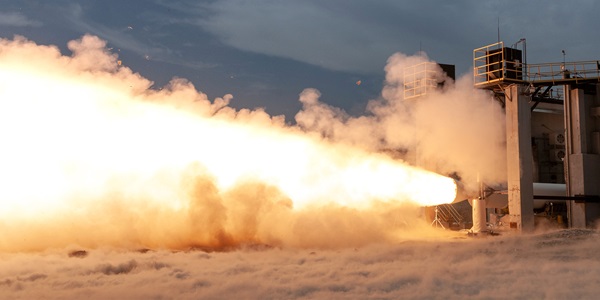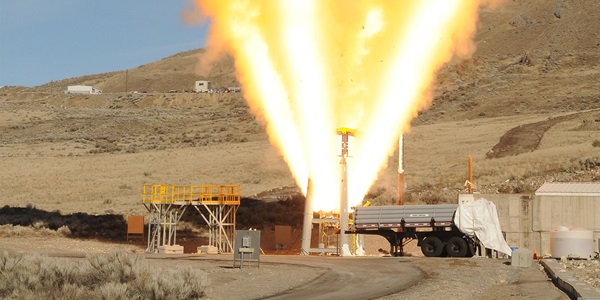Rocket Design Team Helps Launch New Space Opportunities

By Brooks McKinney, APR
Researching and creating new rocket designs can take engineers and manufacturing teams years to test and refine. And then the realization of that effort is complete in nine minutes — the typical time for a rocket to launch into orbit. Outcomes of innovative rocket designs include increasing reliability, decreasing price, or adding new features.
The design work that goes into spearheading this next generation of rocket technology is as detailed and precise as the missions it helps support.

The Emergence of New Rocket Design
Kurt Eberly, director of space launch for Northrop Grumman, explained that requirements for a new rocket design typically emerge in one of two ways. Either a government customer prescribes a new specific need, such as a missile defense interceptor, or Northrop Grumman identifies an emerging opportunity, such as Commercial Resupply Services (CRS), to provide commercial launch services.
The company begins its rocket design process with a detailed systems engineering analysis to ensure that the proposed design satisfies all known mission requirements.
"We review the desired launch market to confirm that our new rocket will have the capabilities to deliver the desired payloads to orbit reliably and cost-effectively," said Eberly.

Applying Rocket Science to Design
After a series of detailed design reviews — a process that can take up to two years — the company begins its design verification process. It's during this phase of the design process that "the real rocket science occurs," Eberly enthused.
"We use a comprehensive set of simulations developed by our guidance, navigation and control engineers to verify that our new rocket will perform as expected in a real launch environment," he said. "Using our decades of launch experience, we're really good at modeling how the rocket will fly through the atmosphere, what levels of drag it will experience and how it will fly in space."
He added that the company uses data from Northrop Grumman launches to continually update and refine these rocket flight simulation models.
Critical Components
Once a rocket design has been verified, manufacturing the major components of the rocket can begin.
Every component of a new rocket involves a critical "make/buy" decision, clarified Eberly.
"We build all our own avionics, a decision that reflects the degree of control we need to have over our rocket configuration," he said. "The timing and sequencing of these high tech computer units is so critical that we can't tolerate a vendor changing something that we didn't know about."
Other major components typically come from a variety of suppliers, added Eberly. The liquid oxygen and kerosene RD-181 engine used in Antares' first stage, for example, is provided by Energomash. The solid rocket motor used in its second stage is produced by Northrop Grumman's Propulsion Systems in Promontory, Utah. And its major composite structures, including the payload fairing, are produced by Northrop Grumman Aerospace Structures in Iuka, Mississippi.

Testing Key Subsystems
Before rocket assembly begins, the company conducts ground tests of the rocket's major subsystems, including its flight computer and rocket motor, particularly before the first flight of a new rocket.
"The flight computer is responsible for steering the rocket, separating its stages, lighting the stages and generally controlling everything about the rocket," emphasized Eberly. "We test it against all the environmental conditions it will experience during flight — something we call the maximum predicted environments (MPE)."
Those MPEs include gravitational acceleration (G) forces, vibration, temperature and shock conditions, he added.
Connecting the Components
The assembly and integration of major components into the final rocket generally occurs as close to the planned launch site as possible.
For Antares, these activities take place at Northrop Grumman's Horizontal Integration Facility (HIF) at NASA's Wallops Flight Facility on Wallops Island, Virginia. Major rocket components, including its multiple stages, composite structures and avionics sections, are shipped to the HIF about six months before launch.
"Once the rocket has been put together, we conduct several leak checks on the first stage, including a leak check between the engine and its core tank," said Eberly. The launch team then moves the rocket to the launch pad for fueling, pivots it up into its vertical launch position and then conducts additional electrical integration tests to make sure everything on the rocket is connected properly for launch.

Weighing the Odds or Orbit
According to Eberly, for the first flights of a new rocket, it's not uncommon to launch either a mass simulator — an inert payload that matches the size and weight characteristics of the planned payload — or an experimental satellite that can tolerate the risk environment of a first or second launch.
"But what if that first launch is successful?" he speculated. "It's always great to have a functioning satellite on top to prove that your rocket can provide the desired gentle ride to orbit."
Launching Dreams
At the end of the day, developing a new rocket is an exacting, disciplined process. Northrop Grumman used its unprecedented history with commercial rocket development to create the Taurus II rocket, renamed Antares in 2011.
“It’s extremely difficult to design, build and launch a new rocket," Eberly said. "People don't see the myriad of details we check and double-check before every launch."
However, Eberly's rocket design and manufacturing teams have a more nuanced perspective.
"These folks work on preparing a new rocket for launch for many years, and then in nine minutes — the typical time from launch to orbit — they get to see whether they did their job properly or not," he noted. "Their work can be exciting, motivating, even a little addicting. It's a great business to be in."
More Innovation Stories
Read all stories about advanced technology and innovation >>


